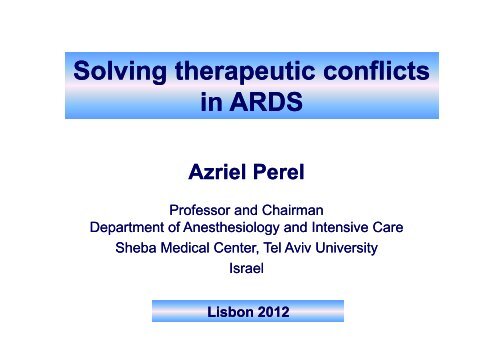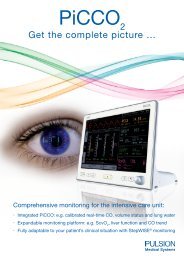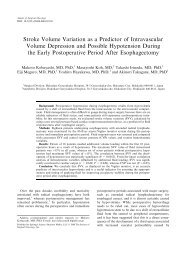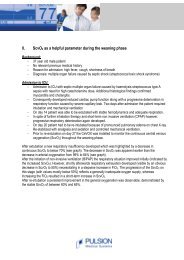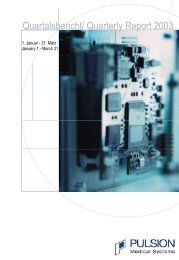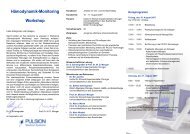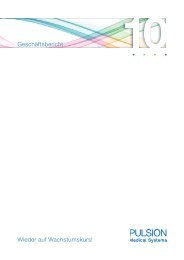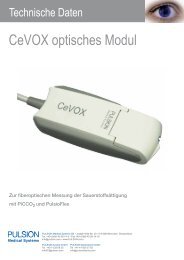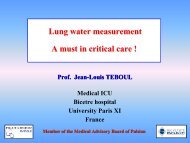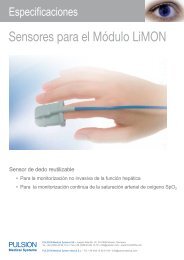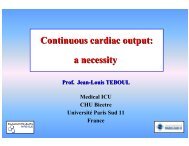Solving therapeutic conflicts in ARDS - PULSION Medical Systems SE
Solving therapeutic conflicts in ARDS - PULSION Medical Systems SE
Solving therapeutic conflicts in ARDS - PULSION Medical Systems SE
You also want an ePaper? Increase the reach of your titles
YUMPU automatically turns print PDFs into web optimized ePapers that Google loves.
<strong>Solv<strong>in</strong>g</strong> <strong>therapeutic</strong> <strong>conflicts</strong><br />
i <strong>in</strong> <strong>ARDS</strong><br />
<strong>ARDS</strong><br />
Azriel Perel<br />
Perel<br />
Professor and Chairman<br />
Department of Anesthesiology and Intensive Care<br />
Sheba <strong>Medical</strong> Center, Tel Aviv University<br />
Israel<br />
Lisbon 2012
Disclosure<br />
The The speaker speaker cooperates with the follow<strong>in</strong>g companies<br />
BMEYE<br />
Pulsion<br />
perelao@shani.net
A A few statements about <strong>therapeutic</strong> <strong>conflicts</strong><br />
�� �� A <strong>therapeutic</strong> conflict is a situation where each<br />
of the possible <strong>therapeutic</strong> decisions carries<br />
some potential potential harm harm.<br />
�� A <strong>therapeutic</strong> conflict is often encountered <strong>in</strong><br />
patients who have more than one fail<strong>in</strong>g organ<br />
system or have significant co co-morbidities.<br />
morbidities.<br />
�� Therapeutic <strong>conflicts</strong> present a great challenge<br />
for protocolized cardiovascular management.<br />
management.<br />
�� A <strong>therapeutic</strong> conflict is where our decisions<br />
can make k th the most t diff difference.
Fluid management g <strong>in</strong><br />
patients with <strong>ARDS</strong><br />
presents one of the most<br />
common and most important<br />
<strong>therapeutic</strong> conflict<br />
f<br />
i <strong>in</strong> the th ICU<br />
ICU
Many of these conditions<br />
are associated with<br />
hemodynamic <strong>in</strong>stability<br />
<strong>in</strong>clud<strong>in</strong>g possible<br />
h hypovolemia<br />
l i
The <strong>in</strong>itial hemodynamic resuscitation<br />
accord<strong>in</strong>g to the SSC guidel<strong>in</strong>es<br />
Dell<strong>in</strong>ger RP, et al. Crit Care Med 2004;32:858-73<br />
2004;32:858 73<br />
Requirements for fluid <strong>in</strong>fusion<br />
are not not easily easily determ<strong>in</strong>ed so<br />
so<br />
that t at repeated epeated fluid u d c challenges a e ges<br />
should be performed.
�� Patients with sepsis-<strong>in</strong>duced sepsis <strong>in</strong>duced ALI had greater<br />
ill illness severity it and d organ dysfunction d f ti at t ALI<br />
ALI<br />
diagnosis and higher crude <strong>in</strong> <strong>in</strong>-hospital hospital mortality<br />
rates compared with non non-sepsis non non-sepsis sepsis ALI ALI patients. patients<br />
�� Patients with sepsis-<strong>in</strong>duced sepsis p <strong>in</strong>duced ALI had a more<br />
positive net fluid balance <strong>in</strong> the first week after<br />
ALI diagnosis.
High g tidal volume and positive p fluid balance are<br />
associated with worse outcome <strong>in</strong> ALI<br />
Sakr Y and the SOAP Investigators. Chest 2005; 128: 3098-108<br />
Sepsis <strong>in</strong> European <strong>in</strong>tensive care units:<br />
results of the SOAP study.<br />
Vi V<strong>in</strong>cent t JL, JL et t al; l SSepsis i OOccurrence i<strong>in</strong> AAcutely t l Ill Patients P ti t Investigators.<br />
I ti t<br />
Crit Care Med. 2006 Feb;34(2):344-53<br />
�� A positive fluid balance is associated with a<br />
worse outcome t <strong>in</strong> i ALI/<strong>ARDS</strong> ALI/<strong>ARDS</strong> and d <strong>in</strong> i acute t kidney kid<br />
<strong>in</strong>jury.<br />
��A A threshold may exist beyond which, after<br />
acute resuscitation, , additional fluid therapy py may y<br />
cause harm.
A conservative strategy of fluid management<br />
improved lung function and shortened the<br />
duration of of mechanical mechanical ventilation ventilation and<br />
and<br />
<strong>in</strong>tensive care without <strong>in</strong>creas<strong>in</strong>g nonpulmonary<br />
pulmonary-organ pulmonary organ failures.<br />
failures
�� Background: Recent studies have suggested that<br />
early goal goal-directed directed resuscitation of patients with septic<br />
shock and conservative fluid management of patients<br />
with acute acute lung lung <strong>in</strong>jury <strong>in</strong>jury (ALI) (ALI) can can improve improve outcomes. outcomes<br />
�� �� Because these may be seen as potentially conflict<strong>in</strong>g<br />
practices, we set out to determ<strong>in</strong>e the <strong>in</strong>fluence of fluid<br />
management on the outcomes of patients with septic<br />
shock complicated by ALI.
�� Mortality <strong>in</strong> 212 patients with ALI complicat<strong>in</strong>g septic<br />
shock was lowest for those achiev<strong>in</strong>g both Adequate<br />
Initial Fluid Resuscitation (AIFR, fluid bolus to a CVP > 8<br />
mm Hg) and Conservative Late Fluid Management<br />
(CLFM (CLFM, even even-to to to-negative negative fluid balance for at least 2<br />
consecutive days).<br />
�� �� M Mortality t lit was hi higher h for f those th achiev<strong>in</strong>g hi i only l AIFR AIFR or<br />
CLFM or neither.<br />
�� �� B Both th early l and d late l t fluid fl id management t of f septic ti shock h k<br />
complicated by ALI can <strong>in</strong>fluence patient outcomes.
Was the amount of fluids adequate or excessive?<br />
Survivors<br />
NNon-survivors i<br />
Was fluid removal adequate or excessive?<br />
Survivors
YES NO<br />
We need to<br />
We need to<br />
stabilize the<br />
prevent<br />
hemodynamic<br />
respiratory<br />
status<br />
deterioration<br />
The conflict <strong>in</strong> adm<strong>in</strong>ister<strong>in</strong>g fluids<br />
to t tto a patient ti t with ith <strong>ARDS</strong><br />
<strong>ARDS</strong>
A Accurate t h hemodynamic d i<br />
assessment is absolutely<br />
necessary <strong>in</strong> order to<br />
correctly solve solve a<br />
<strong>therapeutic</strong> conflict<br />
conflict
Practice parameters for hemodynamic support of sepsis<br />
<strong>in</strong> adult patients. p 2004 update. p<br />
Hollenberg S et al. Crit Care Med 2004; 32:1928-48<br />
PPulmonary l edema d may occur as a<br />
complication of fluid resuscitation<br />
and necessitates monitor<strong>in</strong>g of<br />
arterial oxygenation.
S<strong>in</strong>ger M, Critical Care and Resuscitation 2006, 8:244-5<br />
Would anyone argue that iatrogenic fluid<br />
overload is safe?<br />
Would it it be be more more sensible sensible to to give give guidel<strong>in</strong>es<br />
as to when to use more sophisticated<br />
hemodynamic monitor<strong>in</strong>g monitor<strong>in</strong>g to to better better titrate titrate fluid<br />
<strong>in</strong>put, rather than react post post-drown<strong>in</strong>g?<br />
drown<strong>in</strong>g?
Cl<strong>in</strong>ical exam<strong>in</strong>ation, vital signs, ur<strong>in</strong>e output, Hb, lactate...<br />
EVLW<br />
(PVPI)<br />
Liver function<br />
Preload &<br />
Fluid Fluid responsiveness<br />
responsiveness<br />
ScvO 2<br />
Cardiac Output p<br />
(dP/dT, CFI, GEF)<br />
Intra Intra-abdom<strong>in</strong>al abdom<strong>in</strong>al PP.
�� The desired effect of fluid adm<strong>in</strong>istration is an<br />
<strong>in</strong>crease <strong>in</strong> CO.<br />
�� In the absence of such an <strong>in</strong>crease, it is time to<br />
stop giv<strong>in</strong>g fluids.<br />
�� �� Hence, fluid fluid should should not not be be adm<strong>in</strong>istered adm<strong>in</strong>istered when<br />
there is no fluid fluid-responsiveness.<br />
responsiveness.<br />
CO<br />
Preload
The majority of the parameters<br />
that we rout<strong>in</strong>ely use to guide<br />
X<br />
fluid adm<strong>in</strong>istration are poor<br />
X <strong>in</strong>dicators of when to stop<br />
giv<strong>in</strong>g fluids!<br />
X<br />
X<br />
X<br />
X<br />
V<br />
V V-<br />
X<br />
VV<br />
X V<br />
X<br />
X
�� �� We recommend a a fluid challenge to<br />
predict fluid responsiveness (with a goal<br />
of obta<strong>in</strong><strong>in</strong>g a rise <strong>in</strong> CVP CVP of at least 2<br />
mmHg).
Overall, only 56 56% of the 803<br />
patients <strong>in</strong>cluded <strong>in</strong> 24 studies<br />
responded to a fluid challenge.
A volume change, as a primary diagnostic approach<br />
<strong>in</strong> hemodynamically unstable patients patients, has important<br />
cl<strong>in</strong>ical drawbacks:<br />
�� OOnly l half h lf of f all ll hemodynamically h d i ll unstable t bl<br />
patients are preload responsive.<br />
�� It delays d l primary i therapy th <strong>in</strong> i a sett<strong>in</strong>g tti where h<br />
delayed appropriate treatment has<br />
consequences for survival. survival<br />
� A volume challenge <strong>in</strong> an unresponsive patient<br />
may worsen or precipitate pulmonary edema or<br />
cor pulmonale.
Th The value l of f bedside b d id<br />
measurement of<br />
extra extra-vascular vascular lung water<br />
(EVLW) <strong>in</strong> <strong>in</strong> solv<strong>in</strong>g<br />
solv<strong>in</strong>g<br />
<strong>therapeutic</strong> <strong>conflicts</strong><br />
<strong>conflicts</strong>
At the present time, technology to measure<br />
EVLW is is relatively relatively costly costly, <strong>in</strong>vasive <strong>in</strong>vasive, not widely<br />
available, and has significant methodological<br />
li limitations, i i so we did did not <strong>in</strong>clude i l d it i <strong>in</strong> i the h<br />
def<strong>in</strong>ition.
�� More than half of the patients p with severe sepsis p<br />
but without <strong>ARDS</strong> had <strong>in</strong>creased EVLW, possibly<br />
represent<strong>in</strong>g sub sub-cl<strong>in</strong>ical cl<strong>in</strong>ical lung <strong>in</strong>jury.<br />
�� 25 25% % of <strong>ARDS</strong> patients had normal EVLW.<br />
�� EVLW may improve both risk stratification and<br />
management g of patients p with severe sepsis. p
New criteria for <strong>ARDS</strong><br />
Schuster, Intensive Care Med, 1997<br />
�� Diffuse alveolar edema (EVLW> (EVLW>7ml/kg) ml/kg)<br />
�� �� Increased lung vascular vascular permeability<br />
�� Diffuse Alveolar Damage pathologically
Michard, Fernandez-Mondejar, Kirov, Malbra<strong>in</strong>, Tagami.
In 21% of patients fluid load<strong>in</strong>g<br />
was associated with an<br />
an<br />
<strong>in</strong>crease <strong>in</strong> EVLW of > 10%.
The patient with <strong>ARDS</strong> is more<br />
susceptible to develop pulmonary<br />
edema follow<strong>in</strong>g fluid resuscitation
(Crit Care Med 2010; 38: 000)<br />
�� Increased EVLW is a feature of early <strong>ARDS</strong> and<br />
appears to be reliably measured even with extremely<br />
elevated VD/V D T. T<br />
� The measurement of EVLW may help to better<br />
characterize <strong>ARDS</strong> and to guide g future <strong>therapeutic</strong> p<br />
<strong>in</strong>terventions.
�� EVLWI may reflect a higher fluid balance, which is<br />
an i <strong>in</strong>dependent d d t determ<strong>in</strong>ant d t i t of f mortality t lit and d is i<br />
associated with worse oxygenation and lower<br />
compliance<br />
compliance.<br />
�� The lack of correlation with other oxygenation<br />
yg<br />
parameters and compliance suggests that EVLW may<br />
provide additional <strong>in</strong>formation not available <strong>in</strong> other<br />
parameters.<br />
t
�� �� Elevated EVLW EVLW is a feature of early ALI and<br />
discrim<strong>in</strong>ates between those with ALI and those<br />
without.<br />
�� EVLW predicts progression to ALI <strong>in</strong> patients<br />
with risk risk factors factors for development of of ALI ALI 2.6 6 ± 0.3 3<br />
days before the patients meet the Consensus<br />
criteria for it.<br />
�� These 2.6 6 days may then represent missed<br />
opportunity for <strong>therapeutic</strong> <strong>in</strong>tervention and<br />
improved outcome.
�� �� There was a trend toward higher fluid balance <strong>in</strong><br />
<strong>in</strong><br />
the group <strong>in</strong> whom ALI developed.<br />
�� It is unlikely that the <strong>in</strong>dividuals who had ALI<br />
develop received more fluid because they were<br />
“sicker “sicker,” ” beca because se the the APACHE APACHE II and SAPS scores<br />
were not different between the two groups.<br />
�� This, perhaps, suggests that us<strong>in</strong>g a fluid-<br />
restrictive strategy earlier may have been<br />
beneficial.
YES NO<br />
We can<br />
We may<br />
improve<br />
destabilize<br />
respiratory<br />
hemodynamic<br />
function<br />
status<br />
The conflict <strong>in</strong> remov<strong>in</strong>g fluids<br />
<strong>in</strong> i i<strong>in</strong> a patient ti t with ith <strong>ARDS</strong><br />
<strong>ARDS</strong>
At least 1 day of negative fluid balance<br />
(< 2500 mL) L) achieved hi d bby th the third thi d day d of f<br />
treatment may be a good <strong>in</strong>dependent<br />
predictor of survival <strong>in</strong> patients with<br />
septic p<br />
shock.
Management by target EVLW vs. target PAOP<br />
n=101<br />
22 days y<br />
Mitchell et al, Am Rev Resp Dis 145: 990-998, 1992<br />
* *<br />
9 days<br />
15 days y<br />
7 days<br />
RHC group EVLW group RHC group EVLW group<br />
Ventilation days ICU days
Survivors
Aggressive attempts to achieve<br />
negative fluid balance should be<br />
constantly t tl done<br />
d
�� �� Quantification of EVLW led led to to important<br />
modifications <strong>in</strong> fluid and vasoactive therapy.<br />
�� �� These changes changes generally generally resulted resulted <strong>in</strong> <strong>in</strong> a a lower<br />
lower<br />
volume load<strong>in</strong>g and a positive outcome for the<br />
patient patient.
YES NO<br />
We can<br />
We may<br />
improve<br />
destabilize<br />
respiratory<br />
hemodynamic<br />
function<br />
status<br />
The conflict of apply<strong>in</strong>g or<br />
i <strong>in</strong>creas<strong>in</strong>g i PEEP PEEP level<br />
l l
The lack of significant respiratory<br />
variations is a strong <strong>in</strong>dicator that<br />
the patient may may tolerate aggressive<br />
aggressive<br />
fluid withdrawal and or tolerate high<br />
levels of PEEP.
�� �� Basel<strong>in</strong>e PPV PPV values values accurately accurately predicted<br />
the fluid responsiveness <strong>in</strong> early <strong>ARDS</strong><br />
patients patients.<br />
�� �� A basel<strong>in</strong>e PPV > 12 12% 12 12% % is associated with a<br />
a<br />
significantly <strong>in</strong>crease <strong>in</strong> cardiac <strong>in</strong>dex after<br />
the end of volume volume expansion.<br />
expansion
When presented with a<br />
<strong>therapeutic</strong> conflict, f choose the<br />
l least t harmful h f l option, ti should h ld<br />
your decision decision prove prove to be the<br />
wrong wrong one!
RIGHT WRONG WRONG RIGHT<br />
≤≥<br />
A B
An old patient with with chronic chronic heart failure, failure<br />
sepsis, severe respiratory failure and<br />
h hemodynamic d i <strong>in</strong>stability. i t bilit<br />
CO 1.8 l/m<strong>in</strong> Low<br />
ITBVi 600 ml/m 2 Low<br />
EVLWi 15 ml/kg High<br />
SVV 25-30% 25 30% High
Question Q QQuestion ti 4: 4 What Wh t would ld you do d now? ?<br />
A. Fluids<br />
B. Inotropes<br />
CC. Vasopressors<br />
D. Diuretics<br />
E. I need more <strong>in</strong>formation
Persistent<br />
ti tissue<br />
hypoperfusion<br />
≥<br />
Worsen<strong>in</strong>g of<br />
pulmonary l<br />
edema<br />
RIGHT RIGHT<br />
Inotropes X<br />
Fluids<br />
EVLW
A 63 years old male patient who developed<br />
fulm<strong>in</strong>ant pulmonary edema and hemodynamic<br />
<strong>in</strong>stability dur<strong>in</strong>g re re-total total hip replacement.<br />
Parameter<br />
Normal<br />
range<br />
Interpretation<br />
CI 1 9 l/m2 CI 1.9 l/m 35- 3.5 50 5.0 Low CO<br />
ITBVI 779 ml/m2 ITBVI 779 ml/m 850 -1000 1000 Low preload<br />
SVV 22 %
PACU<br />
Fluid Postop Postop<br />
load<strong>in</strong>g Day 1 Day 2<br />
CI (l/m2 CI (l/m ) 19 375 289 347<br />
2 ) 1.9 3.75 2.89 3.47<br />
ITBVI (ml/m 2 ) 779 1444 !!! 972 1093<br />
SVV % 22 15 8 7<br />
EVLW ( (ml/kg) l/k ) 23 15 5 4<br />
EVLW /<br />
ITBV<br />
1.82 0.73 0.36 0.26
A considerable number of patients<br />
with ith pulmonary l edema d may be b<br />
hypovolemic!
34 yr f female; l V Very severe respiratory i t f failure; il<br />
Hemodynamic collapse; on noradrenal<strong>in</strong>e.<br />
BP 113 / 67 mmHg CI 2 7 l/m<strong>in</strong>/m2 BP 113 / 67 mmHg CI 2.7 l/m<strong>in</strong>/m<br />
HR 91 bpm p<br />
ITBVi 578 ml/m 2<br />
SaO 2 86% !!! EVLWi 20 ml/kg
In patients with severe <strong>ARDS</strong> and<br />
low preload, preload consider consider the the use use of<br />
<strong>in</strong>otropes p before “normaliz<strong>in</strong>g” g<br />
parameters of preload with fluids.
In a situation where<br />
fluid overload may be<br />
particularly<br />
deleterious, only<br />
higher higher-than than-normal normal<br />
PPV values should<br />
serve as <strong>in</strong>dication for<br />
fluid adm<strong>in</strong>istration.
Conclusions<br />
�� �� Fl Fluid id management t of f patients ti t with ith <strong>ARDS</strong> is i<br />
very often associated with a <strong>therapeutic</strong><br />
conflict conflict.<br />
�� Such <strong>therapeutic</strong> <strong>conflicts</strong> should be best<br />
handled by choos<strong>in</strong>g the least harmful<br />
<strong>therapeutic</strong> option.<br />
�� A multi-parametric multi parametric hemodynamic monitor<strong>in</strong>g<br />
approach which which <strong>in</strong>cludes <strong>in</strong>cludes EVLW EVLW <strong>in</strong>creases <strong>in</strong>creases the<br />
the<br />
chance of correct conflict solution.<br />
Thank you for your attention!<br />
perelao@shani.net


